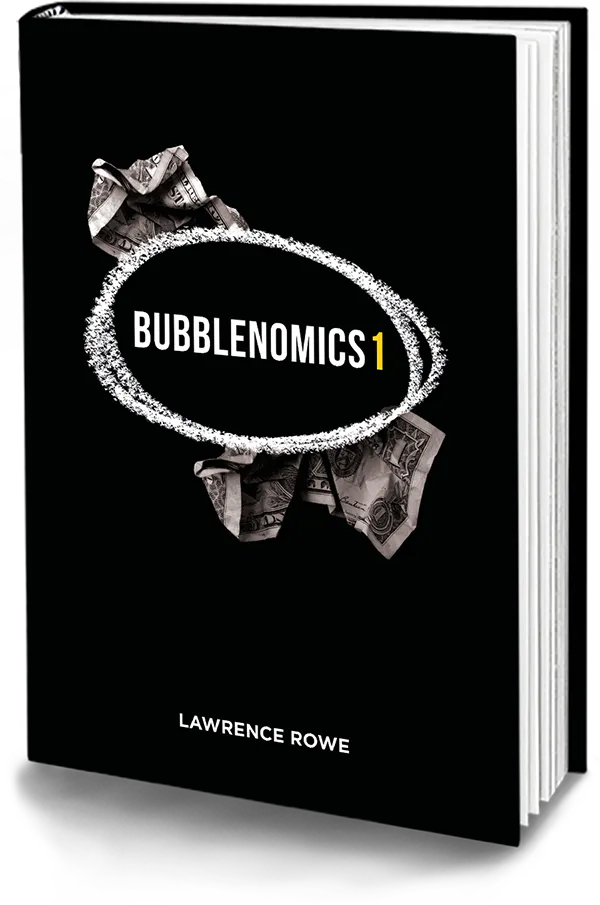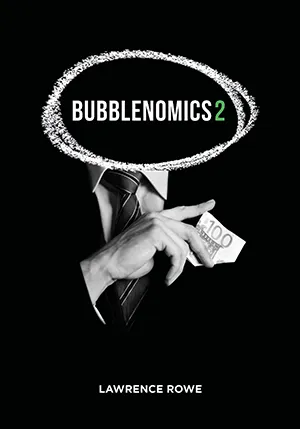BUBBLENOMICS
REVIEWS
TRAILER

OTHER LINKS
SYNOPSIS

Bubblenomics
Economic Bubbles Demystified
Economic bubbles have been engineered throughout history. The housing bubble of the Roaring 2000s which preceded the “Great Recession” had the same cause as the stock-market bubble of the Roaring ’20s which preceded the Great Depression. The present stock and housing bubble has the same cause as the Great Recession and Great Depression. Each bubble is not new and unique, but rather a repetition of the same old pattern. Bubblenomics will teach you that pattern.
bub•ble•nom•ics, noun, the study of the general principles of inflating and deflating economic bubbles, their cyclical creation to exploit the working class, and the fraudulent money system used to engineer them.
Economic bubbles are not inescapable cycles like the seasons or tides, as most people are duped into believing. A public that does not understand economic bubbles is powerless to prevent them. The ultra-rich mystify economic bubbles to increase their wealth and power and to perpetuate debt serfdom. If every American understood Bubblenomics, bankers would no longer be able to manipulate the money system and engineer cyclical economic tsunamis that destroy lives.
America is entering an era of permanent high inflation as we approach the popping point of the most gargantuan economic bubble in the history of the world. Bubblenomics will help you understand unfolding events so that you can prepare for the economic carnage ahead.
EXCERPT
Chapter 2
The Business Cycle
“I know of no severe Depression, in any country or any time, that was not accompanied by a sharp decline in the stock of money, and equally of no sharp decline in the stock of money that was not accompanied by a severe Depression.”
—Milton Friedman
Nobel Prize Winner in Economics
Inflation has counterintuitive consequences which cause a good portion of all human suffering. Let’s examine these consequences using Robinson Crusoe economics. Crusoe economics uses simplified situations to illustrate basic principles.
You’re an orange farmer, I’m an apple farmer. We are the only two businesses in the economy. Everyone works producing apples and oranges; everyone buys only apples and oranges. There is one million dollars in circulation. Each year you grow a half million oranges, I grow a half million apples, each sold for a dollar apiece.
Enter a third character, Speculato, and cue the evil theme music. Speculato prints $100,000. To keep it simple, no bonds are involved. The money supply has been increased, or inflated, by 10%: $1,000,000 (existing) + $100,000 (printed) = $1,100,000 (10% increase).
Unfortunately, the apples and oranges don’t reproduce like rabbits and magically increase their supply by 10%. So, there is a problem. The supply of money has increased, but not the supply of goods & services. Each dollar is therefore worth less. And eventually, if enough new money is printed, worthless.
Prices are a balance between the supply of money and the goods & services it can be traded for. In creating more money but not more goods & services, Speculato disturbed this balance, and prices must adjust to restore it.
If you and I knew that the supply of money had been increased 10%, we would have immediately increased prices 10%. Each apple and orange would immediately cost $1.10 rather than $1.00. Unfortunately, we don’t know the money supply was inflated. Speculato didn’t tell us new money was printed. He lends this new money out to citizens who also don’t know more money has been created.
I work 50 weeks per year and sell 500,000 apples per year, 10,000 apples per week. At $1 per apple, my income is $10,000 per week. Same for you with oranges.
Speculato’s newly created money increases these sales amounts. He spends, or people he lends to spend, $10,000 of his newly created money per week, half on apples, half on oranges. I sell $15,000 worth of apples the next week and you sell $15,000 worth of oranges. It continues a 2nd week. Then a 3rd week. Then a 4th week. . .
In this example I could simply talk to you, and we might deduce that the supply of money had increased. In the real world with millions of businesses such communication is not possible. So, assume we don’t talk to each other.
How, I ask myself, is such an increase in business possible? Only one way. People have decided they like my apples better than your oranges. I think demand has shifted. In my mind, I sold 15,000 apples this week because you only sold 5,000.
Week after week, I sell 50% more apples. My inventory dwindles because it is based on the previous 10,000 apples per week sales projections. To meet this long-term shift in demand, I must buy more land and seed, hire more employees, plant more trees, expand at all levels. I am selling 5,000 more apples a week, there are 50 weeks in my work year, 50 x 5,000 = 250,000. 250,000 more apples sold next year. In my mind, my 500,000 annual apple sales will increase to 750,000. I leverage myself accordingly and grow more apples. You do the same with oranges.
We think we made good investments in the future of our businesses. But we made bad investments: MALINVESTMENT. Increasing the supply of money resulted in inaccurate price signals that tricked us.
Soon everyone feels richer. Those who sold us land, financed it, seed producers, the laborers tilling our new land. The economy is booming.
Until week 11, when Speculato’s magic money runs out and our sales plummet back to 10,000 apples and 10,000 oranges per week. Just a hiccup, we tell ourselves.
Until week 13, when nothing has changed. We look at our new apple and orange trees, realize no one ever really wanted more apples or oranges, and cry. We are ruined. We fire employees, apples and oranges sit rotting, and Crusoeville is far worse off than before Speculato’s infusion of new money.
The formal economic name for this travesty is THE BUSINESS CYCLE. Any normal economy will have some businesses that fail. But inflating the money supply increases the severity of these waves, turning mild ripples into tsunamis.
Substitute houses for apples and a $4.76 trillion money supply for Crusoeville’s $1 million, inflate that money supply by $2.03 trillion rather than $100,000, and you have the U.S. housing bubble.





